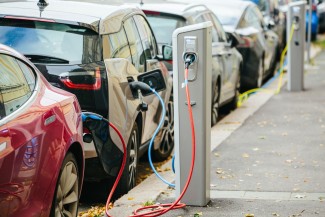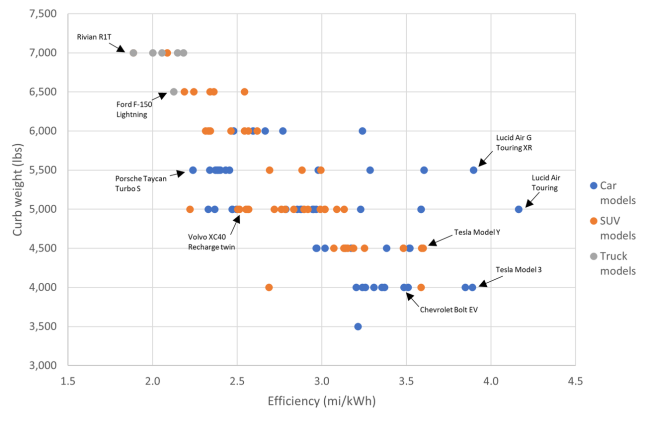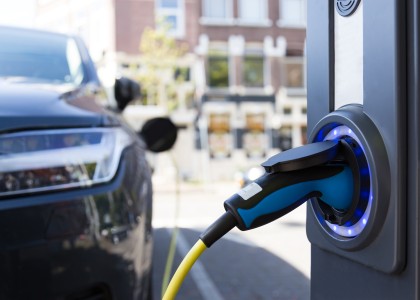The Environmental Protection Agency’s upcoming proposal for new greenhouse gas standards for cars and light-duty trucks starting in model year 2027 needs to address electric vehicle efficiency not only to reduce emissions, but also to lessen the impact EVs have on the electricity grid. With 300 million vehicles expected to be on the road in 2050, fully transitioning to EVs will have a significant impact on the grid. At today’s average EV efficiency of 3.4 miles per kilowatt (mi/kWh) hour,[1] 300 million EVs would add 1.2 million gigawatt-hours of electricity annually, a 31% increase from current electricity consumption.[2] That’s enough electricity to power almost 113 million homes and is consistent with other studies that show a considerable growth in electricity consumption from full or near-full electrification of light-duty vehicles. But if average efficiency was upped to the highest efficiency achieved today of 4.2 mi/kWh, full electrification of the country's light-duty vehicles would add 970,000 gigawatt-hours, 230,000 gigawatt-hours less – enough electricity to power 21 million homes U.S. homes today.
Increasing efficiency and reducing weight can halve EV emissions
Model year 2023 EVs have significantly varying efficiencies, ranging from 1.9 to 4.2 mi/kWh, even among vehicles of similar weight and class. The figure below details the wide range of efficiencies of model year 2023 EVs and how efficiency relates to weight and vehicle type. The least efficient EVs can be half as efficient as the most efficient, meaning double the fueling costs, battery needs, and upstream emissions (from electricity generation, vehicle manufacturing, and mining). Automakers can reduce vehicle weight and improve EV powertrains with more efficient motors and drive axles. Better aerodynamics, more efficient auxiliary systems like air-conditioning, and using waste heat from batteries to heat the cabin when needed also allows more of the battery’s electricity to be used to move the car itself.
Efficiency versus weight in model year 2023 EVs
An example of an EV that has room to improve is the Volvo XC40 Recharge, an SUV weighing 5,000 pounds and achieving an efficiency of only 2.5 mi/kWh. At that efficiency, it contributes about 154 grams of CO2 per mile driven.[3] Over the vehicle’s lifetime, the XC40 Recharge could cause as much as 27.2 metric tons of CO2 emissions. Though below the average emissions of all new vehicles sold today (347 grams of CO2 per mile), the XC40 Recharge nonetheless underperforms most EVs. Increasing its efficiency to 3 mi/kWh, which many vehicles of the same weight reach today, would reduce its emissions to 129 grams per mile and reduce lifetime emissions to 22.7 metric tons, keeping 4.5 metric tons of CO2 out of the atmosphere.
Regulators must address EV efficiency
As the EV market grows, regulators must address efficiency to ensure continued emissions reductions, cost savings for drivers, and a more responsible use of mineral resources in EV batteries. The Environmental Protection Agency (EPA) has historically incentivized greater efficiency of gasoline-powered vehicles through its greenhouse gas emission standards for light-duty vehicles, but the current standards count EVs as having zero CO2 emissions and hence do not reward EV efficiency. As our previous blog post discussed, accurately reflecting the emissions that EVs are responsible for in upcoming EPA standards would be the best next step to ensuring improvement in EV efficiency. Addressing the trend toward larger passenger vehicles would also help EVs achieve greater efficiencies, meaning greater range, lower fueling costs, and less environmental impact from mining for battery materials.
[1] Based on a sales-weighted average of new EVs.
[2] Assumes about 13,500 miles driven annually: www.fhwa.dot.gov/ohim/onh00/bar8.htm.
[3] Based on nationwide grid emissions average and the latest year of data available, 2021.





